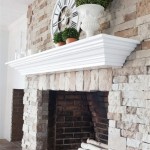What Color to Paint a Brick Fireplace Wall: A Comprehensive Guide
A brick fireplace wall serves as a focal point in many homes, adding character and warmth to the living space. However, the natural color of brick may not always align with the desired aesthetic of a room. Painting a brick fireplace wall offers an opportunity to modernize, brighten, or simply refresh its appearance. The decision of which color to use, however, requires careful consideration of various factors, including the existing décor, the desired mood, and the architectural style of the home.
This article provides a comprehensive guide to selecting the appropriate paint color for a brick fireplace wall, exploring the nuances of different color families, the impact of texture, and practical considerations for achieving a lasting and visually appealing result.
Understanding the Impact of Color Psychology
Color psychology plays a significant role in how we perceive and experience a space. Different colors evoke different emotions and associations, and understanding these effects can help guide the selection process for a brick fireplace wall. Choosing a color that aligns with the desired atmosphere of the room is crucial for creating a cohesive and harmonious environment.
White: White is often associated with cleanliness, purity, and spaciousness. Painting a brick fireplace wall white can create a bright and airy feel, making a room appear larger and more open. White also provides a neutral backdrop that allows other design elements in the room to stand out. However, it is important to consider the existing color palette of the room. A stark white might feel out of place in a space with warmer, more traditional tones. Off-whites or creams can offer a softer, more adaptable alternative.
Gray: Gray is a versatile color that can range from cool and contemporary to warm and inviting. Lighter shades of gray can create a calming and sophisticated atmosphere, while darker grays can add drama and depth. Gray is particularly effective for achieving a modern or minimalist aesthetic. It pairs well with a variety of accent colors and can be used to create a balanced and harmonious space. The specific shade of gray should be chosen based on the existing light in the room. North-facing rooms, which tend to receive cooler light, may benefit from warmer grays with undertones of brown or beige.
Beige and Greige: Beige and greige (a blend of gray and beige) offer a warm and neutral alternative to white and gray. These colors can create a cozy and inviting atmosphere, making them suitable for spaces where comfort and relaxation are prioritized. Beige and greige work well with natural materials, such as wood and stone, and can complement a variety of decorating styles. They are also forgiving colors that can help to conceal imperfections in the brick. Similar to gray, it’s important to consider the undertones. Some beiges can appear yellow, while others lean towards pink or green.
Bold Colors: While neutral colors are generally the safest option for a brick fireplace wall, bold colors can be used to create a striking and unique statement. Colors like navy blue, emerald green, or even deep red can add personality and character to a room. However, it is important to use bold colors judiciously, as they can easily overwhelm a space if not properly balanced. Consider using bold colors as an accent, pairing them with neutral tones on the surrounding walls and furniture. Prior to committing to a bold color, painting a large sample area on the brick and observing it under different lighting conditions is recommended.
Black: Black is a dramatic color choice that can add sophistication and elegance to a brick fireplace wall. It creates a strong focal point and can be particularly effective in rooms with high ceilings or abundant natural light. Black can also be used to conceal visual imperfections in the brick and create a sleek, modern look. However, black can also make a room feel smaller and darker, so it is important to use it sparingly and balance it with lighter colors and reflective surfaces.
Considering the Brick Texture and Condition
The texture and condition of the brick are important factors to consider when choosing a paint color. Porous or heavily textured brick will absorb more paint, potentially requiring multiple coats to achieve the desired coverage. Similarly, damaged or uneven brick may require repairs or surface preparation before painting to ensure a smooth and even finish.
Smooth vs. Textured Brick: Smooth brick surfaces are generally easier to paint and can achieve a more uniform finish. Textured brick, on the other hand, can create a more rustic and interesting look. The texture of the brick can also affect how the paint color appears. For example, a light color on textured brick will highlight the variations in the surface, while a dark color will tend to flatten the appearance.
Brick Porosity: Brick is a porous material, which means it can absorb moisture and paint. This can affect the color and durability of the paint job. Before painting, it is important to clean the brick thoroughly and allow it to dry completely. Applying a primer specifically designed for masonry can help to seal the pores of the brick and improve the adhesion of the paint. The type of primer and paint used should be breathable to allow moisture to escape from the brick, preventing future damage such as spalling (where the brick surface flakes or crumbles).
Brick Condition and Repairs: Before painting, it is important to inspect the brick for any damage, such as cracks, chips, or loose mortar. These issues should be repaired before painting to ensure a smooth and durable finish. Using a masonry repair compound to fill any cracks or holes can help to create a uniform surface. Loose mortar should be removed and replaced with fresh mortar. Ignoring these repairs can lead to further damage and compromise the integrity of the paint job.
Paint Sheen: The sheen of the paint also impacts the overall look. Matte finishes are often preferred for brick as they minimize imperfections and create a softer, more natural look. However, they are less durable and more difficult to clean than paints with a higher sheen level. Eggshell and satin finishes offer a compromise between durability and aesthetics, providing a slightly more reflective surface that is easier to clean. High-gloss finishes are generally not recommended for brick fireplace walls as they can accentuate imperfections and create an overly shiny appearance.
Harmonizing with Existing Décor and Architectural Style
The chosen paint color should complement the existing décor and architectural style of the home. Considering the color palette of the furniture, flooring, and other decorative elements is essential for creating a cohesive and harmonious space. The architectural style of the home can also influence the color selection, as certain colors are more appropriate for specific styles.
Complementary Colors: Consider using complementary colors to create visual interest and balance. Complementary colors are those that are opposite each other on the color wheel, such as blue and orange or yellow and purple. Using complementary colors can create a dynamic and vibrant space. For example, if the room features blue accents, painting the brick fireplace wall a warm orange or terracotta color can create a striking contrast.
Analogous Colors: Analogous colors are those that are adjacent to each other on the color wheel, such as blue, blue-green, and green. Using analogous colors can create a harmonious and calming space. For example, if the room features green accents, painting the brick fireplace wall a shade of blue-green can create a cohesive and relaxing atmosphere.
Architectural Style: The architectural style of the home can also influence the color selection. For example, a traditional colonial home might benefit from classic colors like off-white, beige, or gray. A modern home, on the other hand, might be better suited for bolder colors like black, navy blue, or deep gray. A rustic or farmhouse-style home might benefit from warm, earthy tones like terracotta, brown, or cream. Considering the architectural style of the home can help to ensure that the paint color is appropriate and enhances the overall aesthetic.
Lighting Considerations: Natural and artificial lighting can significantly impact how a paint color appears. Before committing to a specific color, it is important to test it in the room under different lighting conditions. Colors can appear lighter or darker depending on the amount of light they receive. North-facing rooms, which tend to receive cooler light, may benefit from warmer colors. South-facing rooms, which receive warmer light, can handle cooler colors. Artificial lighting can also affect the appearance of colors. Incandescent lighting tends to cast a warm glow, while fluorescent lighting tends to cast a cooler glow. Consider the type of lighting in the room when choosing a paint color.
In conclusion, selecting the appropriate paint color for a brick fireplace wall involves carefully considering factors such as color psychology, the brick's texture and condition, and the existing décor and architectural style. By taking these factors into account, homeowners can choose a paint color that enhances the beauty of the fireplace wall and creates a cohesive and harmonious living space.

Brick Fireplace Makeover Before And After Decorating Painting Id Painted Fireplaces Paint

7 Beautiful Ideas For Painting Interior Brick Fireplaces

Best Paint Colors For A Painted Fireplace Macfarland Painting

30 Gorgeous Painted Brick Fireplace Ideas

The Top Color Ideas For Painting A Brick Fireplace 700 N Cottage

Bold Black Paint Can Turn Even The Most Basic Builder Grade Closet Doors Into Architectural S Home Fireplace Painted Brick Fireplaces Makeover

How To Paint A Brick Fireplace Beamin Moore

42 Painted Brick Fireplace Gorgeous Color

13 Inspiring Colours To Paint Your Brick Fireplace

How To Paint A Brick Fireplace 6 Simple Steps Anew








